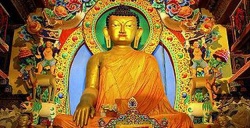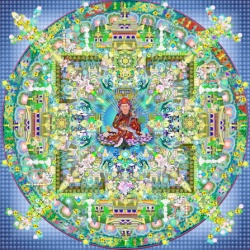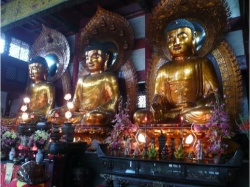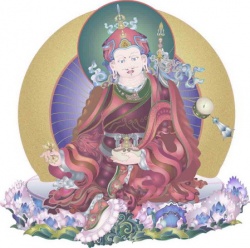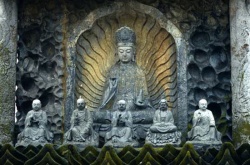Nelug Dzö
' Nelug Dzö' (Tibetan: གནས་ལུགས་མཛོད, Wylie: gnas lugs mdzod) is a poetic vignette written in Classical Tibetan and one of the Seven Treasuries of Longchenpa. Longchenpa wrote 'Desum Nyingpo' (Wylie: sde gsum snying po), a prose autocommentary to this work. Dowman (2006: p.xxiii) considers it a "magical psychotropic poem".
Nomenclature, orthography and etymology
Sanskrit title in IAST: Tathātva-ratna-koṣa-nāma
Importantly, the Tibetan Wylie "ngas lugs" is the analogue of the Sanskrit IAST "Tathātva". The online dictionary of the Tibetan and Himalayan Library (refer: http://www.thlib.org/) identifies "Tathātva" (which is a Sanskrit contraction or compound of "Tathātā" and "Tattva") as synonymous with Tathātā and Dharmatā.
Outline of text
Rigpa Sheda (August 2009) provide the English text outline following Barron, et al. (1998) from whom the Tibetan was sourced as follows:
- The Theme of 'Ineffability' (Tibetan: མེད་པ, Wylie: med pa)
- The Theme of 'Openness' (Tibetan: ཕྱལ་བ, Wylie: phyal ba)
- The Theme of 'Spontaneous Presence' (Tibetan: ལྷུན་གྲུབ, Wylie: lhun grub)
- The Theme of 'Oneness' (Tibetan: གཅིག་པུ, Wylie: gcig pu)
- The Individuals to Whom These Teachings May Be Entrusted
'Spontaneous Presence'
Klein (2002: p. 353) provides a suite of English glosses for 'lhun grub' thus:
- "The term lhun grub can be rendered as spontaneous presence, spontaneous occurrence, spontaneous accomplishment, spontaneous performance, spontaneous complete perfection, or spontaneity."
Intertextuality and themes
The majority of quotations cited by Longchenpa in the Desum Nyingpo are drawn from the tantras of the 'The Collected Tantras of the Ancients' the 'Nyingma Gyubum' (Wylie: rnying ma rgyud 'bum). Out of the Nyingma Gyubum the most quoted tantra in the Desum Nyingpo is the 'Kunjed Gyalpo' (Wylie: kun byed rgyal po) the principal tantra of the 'Mind Series' (Wylie: sems sde) of Dzogchen. Sixteen of the Seventeen Tantras of the Upadesha-varga are quoted at least once on the Desum Nyingpo and the most cited is the principal tantra of this class, the 'Drataljur' or 'Reverberation of Sound' (Tibetan: སྒྲ་ཐལ་འགྱུར, Wylie: sgra thal 'gyur).
English discourse and scholarship
English translations
Barron, et al. of Padma Translation Committee (1998) opened the discourse into English with their translation of the Nelug Dzö in free verse with the Tibetan verse on the facing page for probity along with its prose autocommentary by Longchenpa the Desum Nyingpo, housing both works within the one bound volume. Dowman (2006) has also tendered an English rendering. The numerous embedded quotations from the Seventeen Tantras were referenced and checked by Barron, et al. of Padma Translation Committee (1998: p. 269) against the collection enshrined in the edition printed at Adzom Chögar in eastern Tibet. This Adzom Chögar edition of the versions of the Seventeen Tantra were supplied to Barron, et al. of Padma Translation Committee (1998: p. 269) by Jim Valby who transcribed these texts into Wylie transliteration and these selfsame texts (though revised and more recent versions) have been uploaded onto Wikisource.
Exegesis
Hillis (2002) of the University of Virginia dedicated a thesis to the work. Hillis, in his rhetorical analysis of the Nelug Dzö --defines 'rhetorical' in his usage as both techniques of literary persuasion and literary stylistics—declares his orientation within modern and post-modern literary criticism and discourse. Hillis critiques the penchant of Foucault and Barthes to engage texts by deprecating or completely removing the role of the author from their reading and engagement of a text and instead foregrounding the socio-political context of the text's arising in the experience of the audience, the reader. Hillis, mentions Barthes' famed essay 'Death of the Author' amongst other narratives of post-modern literary criticism, and that he will be employing the socio-political history and biography of Longchenpa (as he understood it within the texts available to him) with his engagement of the Nelug Dzö and thereby reimbodying the text proffers:
- "In fact, The Treasury of Abiding Reality is a remarkable text that instantiates many biographical tensions, which the author, Longchenpa, then works through within the medium of a dense intellectual religious system."
Happenstances in Longchenpa's embedded socio-political context of salience to the Nelug Dzo
Hillis holds that the changing political fortunes of Longchenpa's times and locality, in particular the demise of the political hegemony of the Sakya-Mongol alliance over Central Tibet with the waning of the Mongol Yuan Dynasties influence in internal Tibetan politics with the ascendancy of the Phakmodrupa sect impacted both Longchenpa and informed the Worldview enshrined within the Nelug Dzö :
- "This development is of crucial importance to our consideration of The Treasury of Abiding Reality since the social and political upheaval that accompanied these events had a dramatic impact on Longchenpa and his view of the world."
Happenstances in Longchenpa's personal life of salience to the Nelug Dzo
Hillis also foregrounds two saliences within the experience of Longchenpa and therefore for the Nelug Dzo: the importance of the circumstances around Longchenpa's departure from 'Sangphu Neutok' (Wylie: gsang phu ne'u thog), a monastery famed for its strong scholarship and ascendant tradition of Buddhist Logic and Longchenpa's subsequent view of scholars; "...and his time traveling, studying, and practicing with his 'root guru' (rtsa ba'i bla ma) Kumaradza."
Janchub Gyaltsän, "...the most formidable political and military figure of the day..." and Longchenpa had a "problematic relationship" and Hillis noting the linguistic leitmotif of incarceration and themes of the judicature evident in the Nelug Dzo, holds:
- "...that the text was most likely written during the last ten years of Longchenpa's life, and within that, most likely during his period of self-imposed exile in Bhutan...dating of this text is important since it so clearly seems to be playing on themes of legal procedures and punishments that may well have been inspired by Longchenpa's problematic relationship with Jangchup Gyaltsen."
